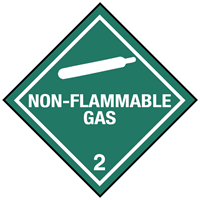
 Print
Print
Chemical Datasheet
1,1,1,2-TETRACHLORO-2,2-DIFLUOROETHANE |

|
Chemical Identifiers
| CAS Number |
UN/NA Number |
DOT Hazard Label |
USCG CHRIS Code |
|
|
|
|
none
|
| NIOSH Pocket Guide |
International Chem Safety Card |
|
1,1,1,2-Tetrachloro-2,2-difluoroethane
|
- 1,1,1,2-TETRACHLORO-2,2-DIFLUOROETHANE
|
NFPA 704
data unavailable
General Description
Colorless solid with a slight, ether-like odor. mp: 40.6°C; bp: 91.5°C.
Hazards
Reactivity Alerts
none
Air & Water Reactions
No rapid reaction with air. No rapid reaction with water.
Fire Hazard
Excerpt from ERG Guide 126 [Gases - Compressed or Liquefied (Including Refrigerant Gases)]:
Some may burn but none ignite readily. Containers may explode when heated. Ruptured cylinders may rocket. CAUTION: Aerosols (UN1950) may contain a flammable propellant. (ERG, 2024)
Health Hazard
Excerpt from NIOSH Pocket Guide for 1,1,1,2-Tetrachloro-2,2-difluoroethane:
Exposure Routes: Inhalation, ingestion, skin and/or eye contact
Symptoms: Irritation eyes, skin; central nervous system depression; pulmonary edema; drowsiness; dyspnea (breathing difficulty)
Target Organs: Eyes, skin, respiratory system, central nervous system (NIOSH, 2024)
Reactivity Profile
1,1,1,2-tetrachloro-2,2-Difluoroethane is non-flammable. Incompatible with active metals such as potassium, sodium, beryllium, powdered aluminum, zinc, magnesium, and calcium. Reacts with acids.
Belongs to the Following Reactive Group(s)
- Fluorinated Organic Compounds
Potentially Incompatible Absorbents
No information available.
Response Recommendations
Isolation and Evacuation
Excerpt from ERG Guide 126 [Gases - Compressed or Liquefied (Including Refrigerant Gases)]:
IMMEDIATE PRECAUTIONARY MEASURE: Isolate spill or leak area for at least 100 meters (330 feet) in all directions.
LARGE SPILL: Consider initial downwind evacuation for at least 500 meters (1/3 mile).
FIRE: If tank, rail tank car or highway tank is involved in a fire, ISOLATE for 800 meters (1/2 mile) in all directions; also, consider initial evacuation for 800 meters (1/2 mile) in all directions. (ERG, 2024)
Firefighting
Excerpt from ERG Guide 126 [Gases - Compressed or Liquefied (Including Refrigerant Gases)]:
Use extinguishing agent suitable for type of surrounding fire.
SMALL FIRE: Dry chemical or CO2.
LARGE FIRE: Water spray, fog or regular foam. If it can be done safely, move undamaged containers away from the area around the fire. Damaged cylinders should be handled only by specialists.
FIRE INVOLVING TANKS: Fight fire from maximum distance or use unmanned master stream devices or monitor nozzles. Cool containers with flooding quantities of water until well after fire is out. Do not direct water at source of leak or safety devices; icing may occur. Withdraw immediately in case of rising sound from venting safety devices or discoloration of tank. ALWAYS stay away from tanks in direct contact with flames. Some of these materials, if spilled, may evaporate leaving a flammable residue. (ERG, 2024)
Non-Fire Response
Excerpt from ERG Guide 126 [Gases - Compressed or Liquefied (Including Refrigerant Gases)]:
Do not touch or walk through spilled material. Stop leak if you can do it without risk. Do not direct water at spill or source of leak. Use water spray to reduce vapors or divert vapor cloud drift. Avoid allowing water runoff to contact spilled material. If possible, turn leaking containers so that gas escapes rather than liquid. Prevent entry into waterways, sewers, basements or confined areas. Allow substance to evaporate. Ventilate the area. (ERG, 2024)
Protective Clothing
Excerpt from NIOSH Pocket Guide for 1,1,1,2-Tetrachloro-2,2-difluoroethane:
Skin: PREVENT SKIN CONTACT - Wear appropriate personal protective clothing to prevent skin contact.
Eyes: PREVENT EYE CONTACT - Wear appropriate eye protection to prevent eye contact.
Wash skin: WHEN CONTAMINATED - The worker should immediately wash the skin when it becomes contaminated.
Remove: WHEN WET OR CONTAMINATED - Work clothing that becomes wet or significantly contaminated should be removed and replaced.
Change: No recommendation is made specifying the need for the worker to change clothing after the workshift. (NIOSH, 2024)
DuPont Tychem® Suit Fabrics
No information available.
First Aid
Excerpt from NIOSH Pocket Guide for 1,1,1,2-Tetrachloro-2,2-difluoroethane:
Eye: IRRIGATE IMMEDIATELY - If this chemical contacts the eyes, immediately wash (irrigate) the eyes with large amounts of water, occasionally lifting the lower and upper lids. Get medical attention immediately.
Skin: SOAP WASH PROMPTLY - If this chemical contacts the skin, promptly wash the contaminated skin with soap and water. If this chemical penetrates the clothing, promptly remove the clothing and wash the skin with soap and water. Get medical attention promptly.
Breathing: RESPIRATORY SUPPORT - If a person breathes large amounts of this chemical, move the exposed person to fresh air at once. If breathing has stopped, perform artificial respiration. Keep the affected person warm and at rest. Get medical attention as soon as possible.
Swallow: MEDICAL ATTENTION IMMEDIATELY - If this chemical has been swallowed, get medical attention immediately. (NIOSH, 2024)
Physical Properties
Flash Point: data unavailable
Lower Explosive Limit (LEL): data unavailable
Upper Explosive Limit (UEL): data unavailable
Autoignition Temperature: data unavailable
Melting Point:
105°F
(NIOSH, 2024)
Vapor Pressure:
40 mmHg
(NIOSH, 2024)
Vapor Density (Relative to Air): data unavailable
Specific Gravity:
1.65
(NIOSH, 2024)
- Denser than water; will sink
Boiling Point:
197°F
at 760 mmHg
(NIOSH, 2024)
Molecular Weight:
203.8
(NIOSH, 2024)
Water Solubility:
0.01 %
(NIOSH, 2024)
Ionization Energy/Potential: data unavailable
IDLH:
2000 ppm
(NIOSH, 2024)
AEGLs (Acute Exposure Guideline Levels)
No AEGL information available.
ERPGs (Emergency Response Planning Guidelines)
No ERPG information available.
PACs (Protective Action Criteria)
No PAC information available.
Regulatory Information
EPA Consolidated List of Lists
No regulatory information available.
CISA Chemical Facility Anti-Terrorism Standards (CFATS)
No regulatory information available.
OSHA Process Safety Management (PSM) Standard List
No regulatory information available.
Alternate Chemical Names
- CFC 112A
- 2,2-DIFLUORO-1,1,1,2-TETRACHLOROETHANE
- 1,1-DIFLUORO-1,2,2,2-TETRACHLOROETHANE
- 1,1-DIFLUOROPERCHLOROETHANE
- F 112A
- FREON® 112A
- HALOCARBON 112A
- R 112A
- REFRIGERANT 112A
- 1,2,2,2-TETRACHLORO-1,1-DIFLUOROETHANE
- 1,1,1,2-TETRACHLORO-2,2-DIFLUOROETANE
- 1,1,1,2-TETRACHLORO-2,2-DIFLUOROETHANE


 Print
Print
